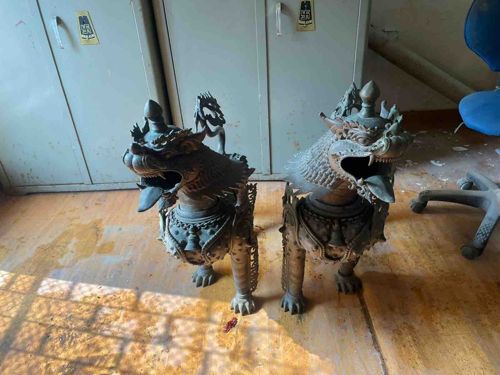
Pair of Southeast Asian Mythical Lion (Chinthe) Statues
This is a pair of impressive and substantial mythical lion (possibly 'Chinthe' or 'Singha') statues, likely originating from Southeast Asia, specifically displaying characteristics often seen in Burmese, Thai, or Cambodian iconography. Each statue stands approximately 34 inches in height, is 30 inches in length, and 11 inches in width, suggesting they are significant decorative or guardian figures. The material appears to be weathered cast metal, possibly bronze or a bronze alloy, exhibiting a rich, dark patination with hints of green and brown, consistent with age and exposure. The intricate detailing on both figures is notable, particularly on the heads which feature open mouths with visible teeth and tongues protruding. The facial expressions are fierce and protective. Each figure is adorned with elaborate crowns or headdresses, indicating their regal or sacred status. Their bodies are covered in finely sculpted scales or fur, and they wear ornate collars or harnesses around their necks and chests, adorned with bell-like elements and intricate patterns. The mythical beasts are depicted standing on four sturdy legs, suggesting stability. The craftsmanship is evident in the detailed casting, showcasing the skill involved in their creation. There are visible signs of wear and surface imperfections consistent with their age and use, including some minor abrasions and accumulated dust/grime in the crevices, contributing to their aged aesthetic. There are no obvious signs of significant damage or repairs, although a thorough examination would be required to confirm. The overall style points to a traditional Southeast Asian artistic period, possibly 19th or early 20th century, but without specific markings, a precise age is difficult to determine from the image alone. The figures appear to be hollow-cast, which is typical for larger metal sculptures of this type. Their size and decorative quality indicate they were likely intended for a prominent architectural setting, such as guarding a temple entrance or as significant interior decor.
AI-Generated Appraisal Disclaimer
Estimated Value
$4,000-6,000
Basic Information
Category
Decorative Arts
Appraised On
November 28, 2025
Estimated Value
$4,000-6,000
Additional Details Provided By Owner
User Provided Information
Size is 34 inches in height 30 inches in length and 11 inches in width
Item Description
This is a pair of impressive and substantial mythical lion (possibly 'Chinthe' or 'Singha') statues, likely originating from Southeast Asia, specifically displaying characteristics often seen in Burmese, Thai, or Cambodian iconography. Each statue stands approximately 34 inches in height, is 30 inches in length, and 11 inches in width, suggesting they are significant decorative or guardian figures. The material appears to be weathered cast metal, possibly bronze or a bronze alloy, exhibiting a rich, dark patination with hints of green and brown, consistent with age and exposure. The intricate detailing on both figures is notable, particularly on the heads which feature open mouths with visible teeth and tongues protruding. The facial expressions are fierce and protective. Each figure is adorned with elaborate crowns or headdresses, indicating their regal or sacred status. Their bodies are covered in finely sculpted scales or fur, and they wear ornate collars or harnesses around their necks and chests, adorned with bell-like elements and intricate patterns. The mythical beasts are depicted standing on four sturdy legs, suggesting stability. The craftsmanship is evident in the detailed casting, showcasing the skill involved in their creation. There are visible signs of wear and surface imperfections consistent with their age and use, including some minor abrasions and accumulated dust/grime in the crevices, contributing to their aged aesthetic. There are no obvious signs of significant damage or repairs, although a thorough examination would be required to confirm. The overall style points to a traditional Southeast Asian artistic period, possibly 19th or early 20th century, but without specific markings, a precise age is difficult to determine from the image alone. The figures appear to be hollow-cast, which is typical for larger metal sculptures of this type. Their size and decorative quality indicate they were likely intended for a prominent architectural setting, such as guarding a temple entrance or as significant interior decor.
Get Your Items Appraised
Instant estimates of your treasures with AI-powered instant appraisals